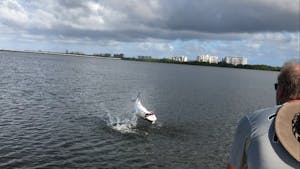The Tarpon (Megalops Atlanticus)

Tarpon are large fish of the genus Megalops. There are two species of Megalops; one native to the Atlantic, and the other to the Indo-Pacific oceans. While fishing in Puerto Rico, we will only encounter the Atlanticus. Megalops Atlanticus is found on the western Atlantic coast from Virginia to Brazil, throughout the coast of the Gulf of Mexico, and throughout the Caribbean.
Tarpon are also found along the eastern Atlantic coast from Senegal to South Angola. They survive in brackish waters (mix of salt and fresh waters) and habitats with low oxygen content due to their swim bladders with which they can breathe air. They roll as they swim, coming up for a sip of air every few minutes. The habitat of the tarpon varies greatly with the developmental stage they are in. Laguna San Jose and Laguna Torrecilla offer some of the best fishing spots for tarpon fishing in Puerto Rico.
While only microscopic at birth, tarpon may grow to lengths of more than eight feet and weigh more than 280 pounds. The average tarpon weighs about 75 to 85 pounds, with many caught fish in Puerto Rico weighing well over 100 pounds. Some catches weigh more than 200 pounds but these are not the normal catch. A fish more than 100 pounds is generally a female, but no one is sure why these larger catches are not equally distributed. They grow very slowly, after a rapid initial growth of about 12 inches in the first year.
Tarpon take 8-10 years to reach sexual maturity and it is believed that tarpon in Puerto Rico can live 60 to 70 years. The oldest tarpon in captivity lived to be 63 years old. Their habitats are characteristically warm, shallow, dark bodies of water with sandy mud bottoms. They also find their way into freshwater creeks, channels, and streams.
As they progress from the juvenile stage to adulthood, they move back to the open waters of the ocean, though many may remain in brackish and freshwater habitats. That is why there are so many different types of tarpon and names for them. The most universally accepted and commonly used terms are:
“Laid up” Tarpon
Small, mid-size or large tarpon that like backwater mangroves, canals, brackish lakes, lagoons or the flats. They are really just hanging out. They may or may not leave, and are almost ready to move out and reproduce, migrate, etc., they just haven’t done so yet.
Baby Tarpon
Small juvenile fish that are incredibly fun to catch. They remain in the safety of the mangroves and the flats to avoid large predators. Many believe that baby tarpon remain in safer backwaters until they are about five to eight years old, but no one has proven this. They are voracious eaters, highly sought after by anglers and are a good target for fishing charter guides in Puerto Rico. If you are just getting started with tarpon fishing on a fly, this might be the way to go.
Resident Tarpon
Mid-size to large fish which essentially don’t migrate or haven’t yet; they usually stay in our lagoons. They stay in one area where food is plentiful (filleting tables on a dock, under bridges or near a waterfront restaurant). Most agree that they will eventually leave, possibly to reproduce and become migrators, or resume migration, but it’s hard to say for sure. There are 60-lb tarpons by the Marina near Cangrejos Yacht Club every day, and most times when someone is trying to catch one, they get spooled, tangled and cut off in about five minutes.
